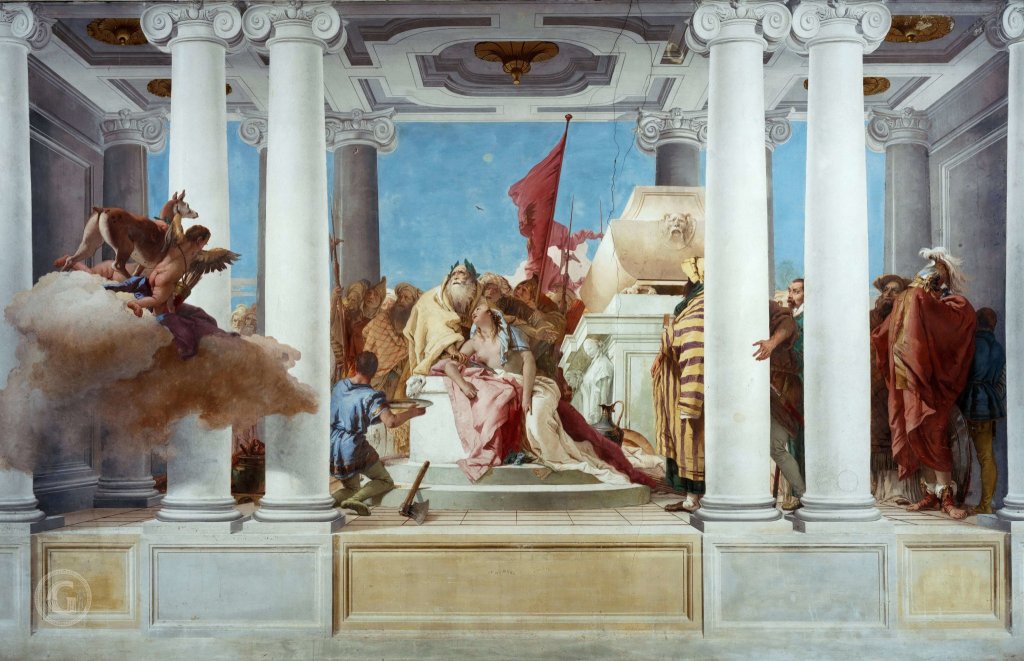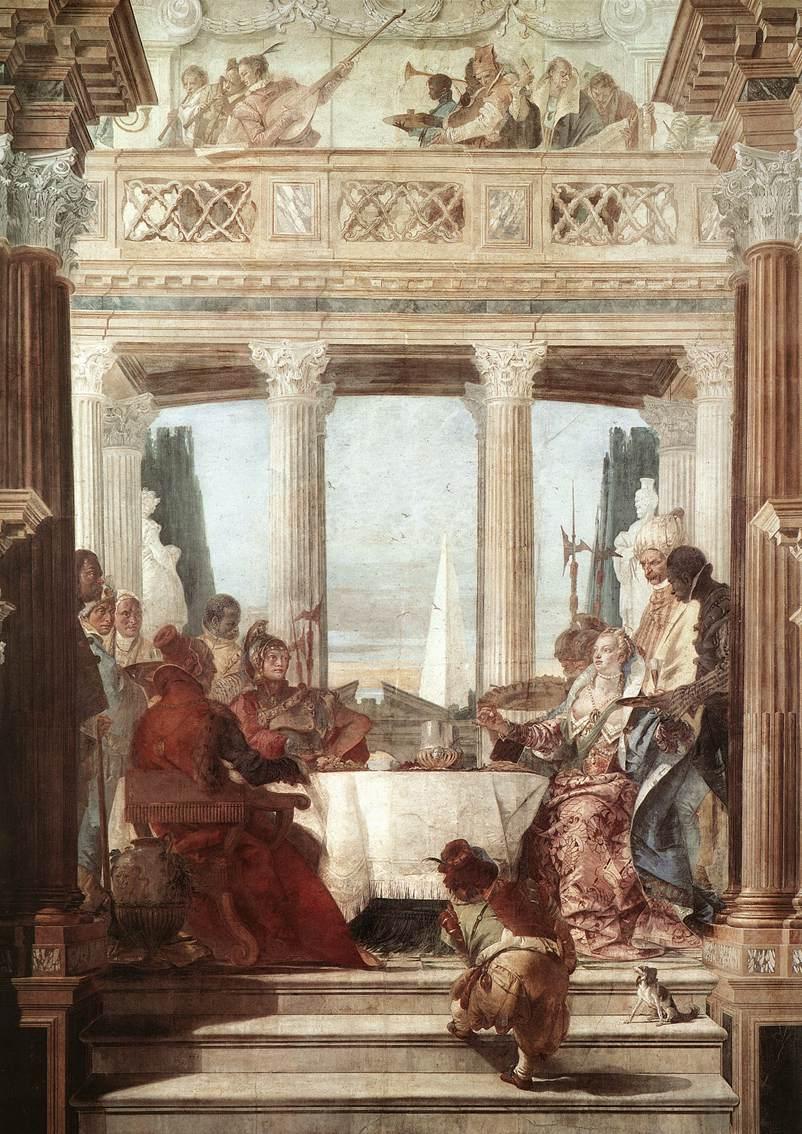Giambattista Tiepolo: escaping the museum room
Tiepolo’s painting lives outside museums, inseparable from the places for which it was created. Here is a comprehensive map.
The development of Giambattista Tiepolo’s art can be experienced almost without setting foot in a museum. His predilection for frescoes makes superb works available in various public places. Single paintings and large decorative cycles are in at least a dozen Italian churches and palaces, as well as Palladian villas in the Vicenza area, his works in Germany and those in Spain, where the artist spent the last part of his life, inspired by historical, allegorical and mythological motifs and styles.

Following a path marked by places more or less open to the public, Tiepolo’s creative life unfolds. It starts from the violent chiaroscuro of the Baroque in the 1710s. It moves towards his much more famous liquid and transparent tones, with the mysterious figure of pulcinella as an example. His loose forms are housed in scenic compositions, designed with the help of the best quadraturists of the time. Tiepolo’s art was constantly nourished by a fruitful model and inexhaustible desire to follow another great Venetian painter: Paolo Veronese.
There is still no reference to Veronese in Giambattista Tiepolo’s oeuvre in the first decades of the 18th century. Between the 1710s and 1720s, the contrast between light and dark still dominates his work, inspired by the baroque style and the strong and resolute pictures of Giovanni Battista Piazzetta. However, Tiepolo’s brushstrokes will soon become large and his tones will become bright, for example in his pictures for the church of Santa Maria dei Derelitti, known as the Ospedaletto church in Venice. Here, Tiepolo’s paintings don’t impose themselves on the viewer as the great cycles of his maturity will do. Instead, there are three long and narrow canvases, wedged almost in dim light between the entablature and three altars. They are The sacrifice of Isaac in the fourth arch on the right; Sant’Andrea and San Giacomo Maggiore in the third arch on the left; San Giovanni and San Tommaso in the first arch: more intense and innovative than those nearby painted by his contemporary Giovanni Battista Pittoni.
We are in 1715 and these canvases are among Tiepolo’s first known works. The Piazzetta model will still resist for a few more years, for example in the 1721 Martyrdom of San Bartolomeo in the church of San Stae (or church of Sant’Eustachio e Compagni martiri) in Venice. Along with Piazzetta, the same church houses works by Pittoni and Ricci, compared to whom Tiepolo’s taste does not differ much. Yet something is changing. The flashes of light are used as brightening effects, not just instruments to contrast the darkness. Piazzetta’s style is about to be abandoned: already in 1724-25, the violent chiaroscuro is forgotten in favor of a tsunami of light in the Triumph of Eloquence frescoed on the ceiling of Palazzo Sandi in Venice.

This is when the illusionistic decoration of large spaces comes into play. Tiepolo’s reference is no longer Piazzetta but Sebastiano Ricci. The most diffused brightness dominates his scenes now, for example in the pictorial cycles with Biblical stories in the gallery and staircase of the archbishop’s palace in Udine. We are between 1726 and 1728. The forms are more and more loose, the edges of the youthful Sacrifice of Isaac have disappeared. Away the contrasts, the halftones advance: his famous liquid pastel tones. It is the general atmosphere that changes. There is a sense of suspension that no longer has anything dramatic to it.

Here begins Tiepolo’s journey towards the great works of his maturity. In this process, the name of Paolo Veronese imposes itself in Tiepolo’s practice like a puzzle, an enigma from which to extract solutions that mix lightness and grandiloquence, intimacy and triumph, sacredness and magic. Veronese will inspire Tiepolo in the creation of the masterpieces of the 1730s and 40s, such as the frescoes of Palazzo Dugnani in Milan (1731), the Colleoni chapel in Bergamo (1732-33), the frescoes of Villa Loschi Zileri in Monteviale near Vicenza (from 1734), up to the enterprises in the Venetian churches, such as that of Gesuati (1737-39) and Sant’Alvise (1739-40), and again in the Carro del Sole frescoed on the ceiling of Palazzo Clerici in Milan in 1740. With Tiepolo, The 16th century Renaissance lives again after the Baroque.


In Palazzo Dugnani in Milan, one needs to stare all the way up in the ballroom to discover the stories of Scipio and Massinissa painted by Tiepolo in collaboration with other painters such as Giovanni Antonio Cucchi and Mattia Bortoloni. During WWII, they were removed for precaution but fortunately returned to their original position afterwards. In the Colleoni Chapel, a famous architecture leaning against the basilica of Santa Maria Maggiore in Bergamo, you can still see the perfectly preserved frescoes by Tiepolo with scenes from the Martyrdom of John the Baptist at the base of the dome, the allegorical figures in the sails and the lunettes of the altar.

It is in the decoration of the staircase and of the hall on the noble floor of Villa Loschi Zileri in Monteviale that Tiepolo shows his full maturity in a spectacular way: twelve frescoes populated with mythological figures, flooded with light and made without assistants in a very short time. The 1730s, 40s and 50s are intense decades for the artist, who gets commissioned for great cycles of paintings and altarpieces. However, it is in the frescoes that Tiepolo’s interpretation of Veronese’s work is best expressed, unfolding throughout his mature production, as for example in the stories of Antonio and Cleopatra painted in Palazzo Labia, undoubtedly one of the his greatest masterpieces, created with the collaboration of the quadraturist Gerolamo Mengozzi Colonna.

Giambattista Tiepolo is neither the first nor the last to take Veronese as his model. The 16th century artist’s ceilings in the Palazzo Ducale in Venice are inspiration for Pietro da Cortona in his 1830s frescoed hall in the Palazzo Barberini in Rome, and for Rubens in his pictures for the ceiling of the Banqueting House in London. Even after the 18th century, several great artists declared their debt to Veronese, Delacroix and Cézanne among others. A follower of Veronese is Sebastiano Ricci, himself among the first references of Tiepolo. Yet in Tiepolo the debt towards Veronese is something different. It is as if Tiepolo metabolizes Veronese to express innovative artistic values.
The art historian William L. Barcham pointed this out with a precise example. “In 1744 Tiepolo frescoed two scenes from ancient history in the hall of Villa Cordellina in Montecchio Maggiore. He based himself on works by his predecessors for both Dario’s family in front of Alessandro and for Scipio’s Magnanimity. In particular, the painting of Alessandro seems to imitate, in the modern and pejorative sense of the word, Veronese’s picture of the same subject, now in London, at the National Gallery. It was painted around 1565 and was visible in the Pisani Moretta Palace when Tiepolo painted some frescoes in the same place in 1743, shortly before starting to work in Montecchio Maggiore. However, the close comparison between Alessandro’s two stories reveals how Tiepolo, in emulating the Renaissance master, changed almost everything, transforming the instruments, the rhythms, the compositional keys, that is to say he changed the Veronesian tonal characteristics.”

In fact, not only the technique and the dimensions are different between the two painters. Veronese’s oil colors are strongly saturated with ruby red, while Tiepolo dilutes each hue to create the glow of a diffused and natural light. Veronese sets Dario’s family in a courteous scene, while Tiepolo transports the scene to a royal encampment outside the city. Despite these differences, Tiepolo mostly adopts the general sense of composition of his predecessor. From mature works onwards, as Veronese did, Tiepolo arranges the characters as if they were on a stage, identifying the protagonists and pushing the supporting actors to the margins, dividing the characters into small groups with caesuras that are always logical, even when certain mysterious extras peep out for no apparent reason.
These elements are also found in the artist’s work in Germany, in the decoration of the Würzburg Residence where Tiepolo and his sons are called by the Prince Bishop Karl Philipp von Greiffenclau in 1750 to execute an extensive decoration of the palace. In Würzburg, Tiepolo creates very daring compositions where the figures partially overlap with the colored stucco frames. Human, animal and allegorical figures are mounted in an unbridled composition previously unseen in Tiepolo’s other works and not even in subsequent masterpieces, such as the decoration of Villa Valmarana near Vicenza and in other late works: among these, Villa Contarini in Mira on the river Brenta; villa Pisani in Stra; the ceilings of Ca ‘Rezzonico in Venice.

In 1762, Tiepolo left Italy and would never come back. Charles III, king of Spain, calls him to decorate the Royal Palace in Madrid, where he paints three scenes: Aeneas being led to the temple of Venus, Apotheosis of Spain, and Triumph of the Spanish Monarchy, perhaps the most successful of the three. The 70 years old painter begins to see his creativity fade. Times have changed. The neoclassical taste is taking hold of the Spanish court, while in Italy new names, Andrea Appiani for example, are interpreting the new course of painting. After having revived the spirit of Paolo Veronese in the 18th century, and having been celebrated and admired throughout Europe, Tiepolo passes away in 1770, along with a season whose spirit he had wonderfully interpreted.
Tiepolo’s recognition is not immediate after his death, and his art is partially forgotten for more than a century. Roberto Calasso, who dedicated a fascinating essay to Tiepolo, explains the reasons for this fate: “Between the softness of Greuze and the rigidity of Mengs, which correspond punctually to the obtuse and fatal course of history, Tiepolo is an obstacle and a slight aberration, as we say of the course of a planet. It serves neither to illuminate the past nor to project oneself into the future. He is not a modern before the moderns, according to the formula that will be applied trivially to Goya. He is not archaic either. How could he, if he emanates so much insolence and contempt? Tiepolo is an extreme example of Taoist fluency in art, an inconceivable quality in his practice, never again achieved afterwards. If he was put aside for a century, if some of his canvases lay rolled up in warehouses, it was only because history rightly perceived him as an intruder, while he worked tenaciously to thicken sensitivities, to make them more raw.”

November 25, 2020
